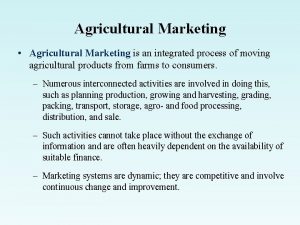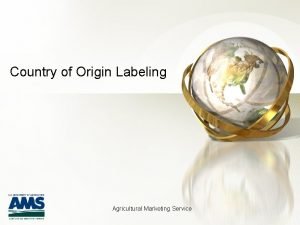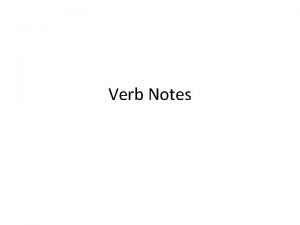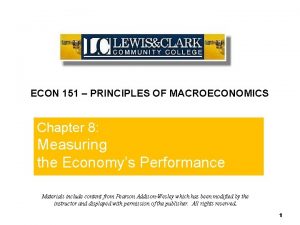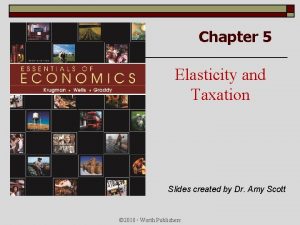ECON 339 X Agricultural Marketing Chad Hart Assistant



































- Slides: 35

ECON 339 X: Agricultural Marketing Chad Hart Assistant Professor/Grain Markets Specialist chart@iastate. edu 515 -294 -9911 Econ 339 X, Spring 2010

Today’s Topic World Ag. Supply and Demand Update Price Issues Econ 339 X, Spring 2010

U. S. Corn Supply and Use 2007 2008 2009 2010 93. 5 86. 0 86. 5 88. 8 Area Planted (mil. acres) Yield (bu. /acre) 150. 7 153. 9 164. 9 160. 9 Production (mil. bu. ) 13, 038 12, 092 13, 131 Beg. Stocks (mil. bu. ) 1, 304 1, 624 1, 673 1, 899 Imports (mil. bu. ) 20 14 10 15 Total Supply (mil. bu. ) 14, 362 13, 729 14, 814 15, 045 Feed & Residual (mil. bu. ) 5, 913 5, 246 5, 450 5, 350 Ethanol (mil. bu. ) 3, 049 3, 677 4, 300 4, 500 Food, Seed, & Other (mil. bu. ) 1, 338 1, 276 1, 265 1, 290 Exports (mil. bu. ) 2, 437 1, 858 1, 900 2, 100 Total Use (mil. bu. ) 12, 737 12, 056 12, 915 13, 240 Ending Stocks (mil. bu. ) 1, 624 1, 673 1, 899 1, 805 4. 20 4. 06 3. 60 Season-Average Price ($/bu. ) Econ 339 X, Spring 2010 Source: USDA, with my modifications for 2010 acreage

World Corn Production Econ 339 X, Spring 2010 Source: USDA

U. S. Soybean Supply and Use 2007 2008 2009 2010 Area Planted (mil. acres) 64. 7 75. 7 77. 5 78. 1 Yield (bu. /acre) 41. 7 39. 7 44. 0 42. 9 Production (mil. bu. ) 2, 677 2, 967 3, 359 3, 307 Beg. Stocks (mil. bu. ) 574 205 138 190 Imports (mil. bu. ) 10 13 15 8 Total Supply (mil. bu. ) 3, 261 3, 185 3, 512 3, 505 Crush (mil. bu. ) 1, 803 1, 662 1, 730 1, 655 Seed & Residual (mil. bu. ) 93 101 148 168 Exports (mil. bu. ) 1, 159 1, 283 1, 445 1, 325 Total Use (mil. bu. ) 3, 056 3, 047 3, 322 3, 147 Ending Stocks (mil. bu. ) 205 138 190 358 10. 10 9. 97 9. 45 8. 80 Season-Average Price ($/bu. ) Econ 339 X, Spring 2010 Source: USDA, with my modifications for 2010 acreage

World Soybean Production Econ 339 X, Spring 2010 Source: USDA

Seasonal Patterns Ø A price pattern that repeats itself with some degree of accuracy year after year. ØSupplies and demand ØOften sound reasons ØWidely known ØLinked to storage cost or basis patterns in grains ØLinked to conception and gestation in livestock Econ 339 X, Spring 2010

Seasonal Pricing Patterns Econ 339 X, Spring 2010 Source: USDA, NASS, Monthly Price Data 1980 -2008

Charting Channel lines Econ 339 X, Spring 2010

Sell Signal A sell signal is one close below the charting lines Sell signal Econ 339 X, Spring 2010

Buy Signal Some chartists need only one close above the charting line to create a buy signal, others use two closes above. Buy signal Econ 339 X, Spring 2010

Key Reversal A key reversal is when the daily high and low price range exceed the price range for the previous two days. Econ 339 X, Spring 2010

Gaps often occur when a major new piece of information hits the market. They are often filled in by later price movements. Econ 339 X, Spring 2010

Double Tops & Bottoms Double tops and bottoms show prices with major technical resistance. These can be several days apart. Econ 339 X, Spring 2010

Head & Shoulders Econ 339 X, Spring 2010 Source: Figure 7, Charting Commodity Futures Ag Decision Maker, File A 2 -20

Moving Averages 9 day average 18 day average 40 day average Sell signal Buy signals Econ 339 X, Spring 2010

Relative Strength Index ØLooks at last X days worth of closing prices ØX = 9, 14, 30, etc. ØSummarizes upward and downward price movements during the period ØRecord the last 14 days worth of price changes, based on closing prices ØSum the positive and negative price changes and create average for each ØRelative Strength Index = (Up average/(Up average + Down average))*100 Econ 339 X, Spring 2010

Relative Strength Index RSI for July 2010 Corn Econ 339 X, Spring 2010

Relative Strength Index RSI’s above 70 (80) are considered signals of a market due to decline RSI’s below 30 (20) are considered signals of a market due to rally Econ 339 X, Spring 2010

Does Technical Analysis Work? Arguments for it: ØReal world markets are not perfectly rational ØMarkets may be slow to respond to new information ØTechnical analysis works with the psychological biases ØIt works because so many people use it ØSelf-fulfilling Arguments against: ØEfficient market hypothesis ØThe current price holds all of the relevant information Econ 339 X, Spring 2010

Convergence Issues Typically, as futures contracts reach maturity, futures price and cash prices at delivery points tend to converge to the same level. For several grain and oilseed futures contracts over the last few years, this has not occurred. “Poor Convergence Performance of CBOT Corn, Soybean and Wheat Futures Contracts: Causes and Solutions” ØScott Irwin, Philip Garcia, Darrel Good, and Eugene Kunda ØUniversity of Illinois, March 2009 Econ 339 X, Spring 2010

Corn (Lack of) Convergence Econ 339 X, Spring 2010 Source: Irwin, Garcia, Good, and Kunda, 2009 Marketing and Outlook Research Report 2009 -02

Soybean (Lack of) Convergence Econ 339 X, Spring 2010 Source: Irwin, Garcia, Good, and Kunda, 2009 Marketing and Outlook Research Report 2009 -02

Wheat (Lack of) Convergence Econ 339 X, Spring 2010 Source: Irwin, Garcia, Good, and Kunda, 2009 Marketing and Outlook Research Report 2009 -02

Why Is Convergence An Issue? 1. Non-convergence indicates the market is outof-balance. “When a contract is out of balance the disadvantaged side ceases trading and the contract disappears. ” (Hieronymus, 1977) 2. Non-convergence adds to the uncertainty in basis and limits hedging effectiveness. Econ 339 X, Spring 2010 Source: Irwin, Garcia, Good, and Kunda, 2009 Marketing and Outlook Research Report 2009 -02

Factors Ø The relationship between the spread between futures contracts and the cost of carry (think storage costs) Ø In the settlement process for corn and soybean futures, the delivery instrument is a shipping certificate. Ø If it is advantageous to the holder of a shipping certificate, they can delay delivery and effectively store the grain, paying CBOT set storage costs. Ø Structural issues related to the delivery process Ø Does the general trade flow of the commodity line up with the possible delivery points under the futures contract? Econ 339 X, Spring 2010 Source: Irwin, Garcia, Good, and Kunda, 2009 Marketing and Outlook Research Report 2009 -02

Spread vs. Carry Look at the ratio of the futures spread versus the cost of carry Futures Price. Next – Futures Price. Nearby Storage Costs + Interest Irwin, et al. found lack of convergence when ratio is high (> 80%) A lower ratio implies smaller returns to holding a shipping certificate and more offsetting positions are taken, lowering futures prices. If the commodity is still in storage, then cash sales aren’t happening, lowering cash prices. Econ 339 X, Spring 2010 Source: Irwin, Garcia, Good, and Kunda, 2009 Marketing and Outlook Research Report 2009 -02

Delivery Points How much of the commodity is moving through the delivery point areas? Corn Econ 339 X, Spring 2010 Soybeans Wheat Source: Irwin, Garcia, Good, and Kunda, 2009 Marketing and Outlook Research Report 2009 -02

Convergence vs. Carry - Corn Econ 339 X, Spring 2010 Source: Irwin, Garcia, Good, and Kunda, 2009 Marketing and Outlook Research Report 2009 -02

Convergence vs. Carry - Soy Econ 339 X, Spring 2010 Source: Irwin, Garcia, Good, and Kunda, 2009 Marketing and Outlook Research Report 2009 -02

Possible Reasons for High Ratios 1. CBOT storage rates below commercial storage rates 2. Large “long-only” index funds rolling to the next contract at the same time 3. Large risk premiums built into futures to cover uncertainty Irwin, et al. found support for #1 and arguments for #3, but did not find support for #2. Econ 339 X, Spring 2010 Source: Irwin, Garcia, Good, and Kunda, 2009 Marketing and Outlook Research Report 2009 -02

Possible Remedies 1. Increase CBOT storage rates Ø Done for corn and soybeans in late 2008 2. Change delivery points to include more of the commodity shipping area Ø Mostly an issue for wheat Other proposals: Ø Move to cash settlement Ø Force delivery Ø Limit the number of certificates that can be held Econ 339 X, Spring 2010 Source: Irwin, Garcia, Good, and Kunda, 2009 Marketing and Outlook Research Report 2009 -02

Relative Basis Change - Corn The closer this is to one, the more effective hedging is. Econ 339 X, Spring 2010 Source: Irwin, Garcia, Good, and Kunda, 2009 Marketing and Outlook Research Report 2009 -02

Relative Basis Change - Soy The closer this is to one, the more effective hedging is. Econ 339 X, Spring 2010 Source: Irwin, Garcia, Good, and Kunda, 2009 Marketing and Outlook Research Report 2009 -02

Class web site: http: //www. econ. iastate. edu/classes/econ 339/hartlawrence/ Econ 339 X, Spring 2010
 Hrt to hrt merrylands
Hrt to hrt merrylands 8883396469
8883396469 Chapter 4 lesson 8 quadratic functions
Chapter 4 lesson 8 quadratic functions Agricultural marketing communications
Agricultural marketing communications What is agricultural marketing circle?
What is agricultural marketing circle? Scope of agricultural marketing
Scope of agricultural marketing Marketing mix of agricultural products
Marketing mix of agricultural products Chad b swim helping verbs
Chad b swim helping verbs Gps vtg
Gps vtg Ilan raymond
Ilan raymond Chad ulven
Chad ulven Wiu gis
Wiu gis Six sigma
Six sigma Chad topaz
Chad topaz Chad ostlund
Chad ostlund Chad posner
Chad posner Addi vs chad
Addi vs chad Fruit growers laboratory
Fruit growers laboratory Chad blight
Chad blight Mainframe ransomware
Mainframe ransomware Chad braley
Chad braley Chad green laetrile
Chad green laetrile Chad gifford columbia
Chad gifford columbia Synergy puhsd
Synergy puhsd Chad meyerhoefer
Chad meyerhoefer Soil erosion control measures
Soil erosion control measures Chad kessens
Chad kessens Chad imperialism
Chad imperialism Chad eggerman
Chad eggerman What is government expenditure multiplier
What is government expenditure multiplier Fiscal policy definition
Fiscal policy definition Flipit econ
Flipit econ Econ 151
Econ 151 Midpoint method formula
Midpoint method formula Mpc ap econ
Mpc ap econ Marginal analysis in economics
Marginal analysis in economics



